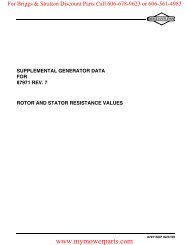GENERATOR
You also want an ePaper? Increase the reach of your titles
YUMPU automatically turns print PDFs into web optimized ePapers that Google loves.
Portable Generator Familiarization & Troubleshooting Guide<br />
Section 1 • Generator Fundamentals<br />
UNITS OF ELECTRICAL MEASUREMENT<br />
Just as a hydraulic system must have specific values:<br />
• Rate of flow.<br />
• Pressure.<br />
• Resistance to flow.<br />
Relavent established values can also be expressed for an<br />
electrical circuit. Fluid flow values in a hydraulic system are<br />
generally expressed as:<br />
• Gallons per minute.<br />
• Pounds per square inch.<br />
• Pressure drop or pressure differential.<br />
Electron flow (current) through a conductor can be<br />
compared to the flow of hydraulic fluid through a hose<br />
(Table 1.2).<br />
Table 1.2 — Hydraulic Flow Versus Current Flow<br />
The units of measure for an electrical circuit are:<br />
• Volts - Pressure.<br />
• Amperes - Rate of Flow.<br />
• Ohms - Resistance to Flow. (Figure 1.16)<br />
Figure 1.16 — Electrical Measurement Units<br />
Ampere - Unit of Current Flow<br />
The rate of electron flow through a conductor is measured<br />
in amperes, which is a measurement of electrons flowing<br />
past a given point in a given time. One ampere is equal to a<br />
little over six thousand million billion electrons per second!<br />
Written numerically, the figure looks like this:<br />
6,000,000,000,000,000,000.<br />
Volt - Unit of Pressure<br />
The volt is a measurement of the difference in electrical<br />
potential (EMF) that causes electrons to flow in a circuit.This<br />
difference in electrical potential (or electro-motive force)<br />
may be described as the difference between the number of<br />
positive charges and the number of negative charges.Thus,<br />
voltage may be described as the potential of electrical<br />
unbalance and current flow is the attempt to regain that<br />
balance.<br />
One volt is the amount of electro-motive force (EMF) that<br />
will result in a current (electron) flow of one ampere<br />
through a resistance of one ohm.<br />
Ohm - Unit of Resistance<br />
The electron may be compared to an individual trying to<br />
make his way through a crowd of people, meeting the<br />
resistance of human bodies every step of the way. In any<br />
conductor or circuit, there is a resistance to electron flow.<br />
10






